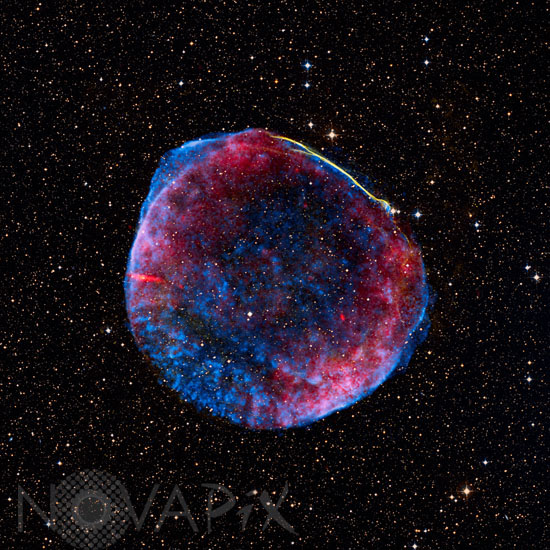Photo Agency - Astronomy - Space - Nature

Supernova remnant SN 1006
author: Nasa/CXC/SAO/ Noao/NRAO/Novapix
reference: a-snv11-01000
Image Size 300 DPI: 28 * 28 cm
Just over a thousand years ago, the stellar explosion known as supernova SN 1006 was observed. It was brighter than Venus, and visible during the day for weeks. The brightest supernova ever recorded on Earth, this spectacular light show was documented in China, Japan, Europe, and the Arab world. Astronomers now understand that SN 1006 was caused by a white dwarf star that captured mass from a companion star until the white dwarf became unstable and exploded. Recent observations of the remnant of SN 1006 reveal the liberation of elements such as iron that were previously locked up inside the star. Because no material falls back into a neutron star or black hole after this type of supernova explosion, the liberation of this star's contents is complete. This is a composite image of the SN 1006 supernova remnant, which is located about 7000 light years from Earth. Shown here are X-ray data from NASA's Chandra X-ray Observatory (blue), optical data from the University of Michigan's 0.9 meter Curtis Schmidt telescope at the NSF's Cerro Tololo Inter-American Observatory (CTIO; yellow) and the Digitized Sky Survey (orange and light blue), plus radio data from the NRAO's Very Large Array and Green Bank Telescope (VLA/GBT; red).
Keywords for this photo:
2003 - 2008 - ASTRONOMY - CHANDRA - COMPOSITE - EVOLUTION - LUPUS - RADIO - SN 1006 - STAR - SUPERNOVA - SUPERNOVA REMNANT - WHITE DWARF - X - X-RAY -
Contact : Stéphane Aubin +33-(0)9-51-26-53-76
© Novapix - All rights reserved


